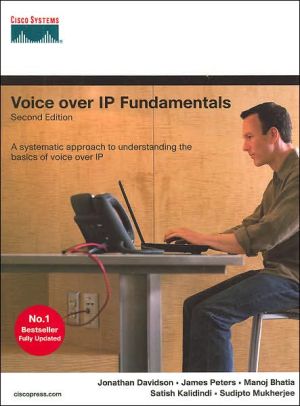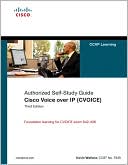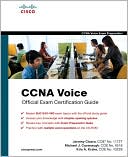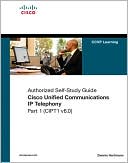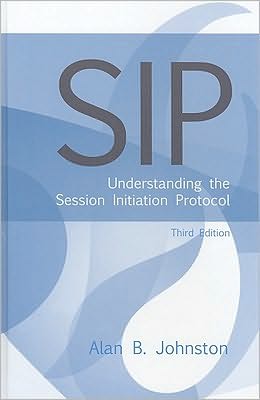Voice over IP Fundamentals: Second Edition (Cisco Press Fundamentals Series)
A systematic approach to understanding the basics of voice over IP\ \ Understand the basics of enterprise and public telephony networking, IP networking, and how voice is transported over IP networks\ Learn the various caveats of converging voice and data networks\ Examine the basic VoIP signaling protocols (H.323, MGCP/H.248, SIP) and primary legacy voice signaling protocols (ISDN, C7/SS7)\ Explore how VoIP can run the same applications as the existing telephony system but in a more...
Search in google:
A systematic approach to understanding the basics of voice over IPUnderstand the basics of enterprise and public telephony networking, IP networking, and how voice is transported over IP networks Learn the various caveats of converging voice and data networks Examine the basic VoIP signaling protocols (H.323, MGCP/H.248, SIP) and primary legacy voice signaling protocols (ISDN, C7/SS7) Explore how VoIP can run the same applications as the existing telephony system but in a more cost-efficient and scalable manner Delve into such VoIP topics as jitter, latency, packet loss, codecs, QoS tools, and securityVoice over IP (VoIP) has become an important factor in network communications, promising lower operational costs, greater flexibility, and a variety of enhanced applications. To help you understand VoIP networks, Voice over IP Fundamentals provides a thorough introduction to the basics of VoIP.Voice over IP Fundamentals explains how a basic IP telephony infrastructure is built and works today, major concepts concerning voice and data networking, and transmission of voice over data networks. You’ll learn how voice is signaled through legacy telephone networks, how IP signaling protocols are used to interoperate with current telephony systems, and how to ensure good voice quality using quality of service (QoS).Even though Voice over IP Fundamentals is written for anyone seeking to understand how to use IP to transport voice, its target audience comprises both voice and data networking professionals. In the past, professionals working in voice and data networking did not have to understand each other’s roles. However, in this world of time-division multiplexing (TDM) and IP convergence, it is important to understand how these technologies work together. Voice over IP Fundamentals explains all the details so that voice experts can understand data networking and data experts can understand voice networking.The second edition of this best-selling book includes new chapters on the importance of billing and mediation in a VoIP network, security, and the common types of threats inherent when packet voice environments, public switched telephone networks (PSTN), and VoIP interoperate. It also explains enterprise and service-provider applications and services.
\ \ Chapter 4: Signaling System 7\ Congestion Control\ MTP2 monitors the level of messages queued in buffers (both output and retransmission) and alerts SNM in case of congestion.\ Onset of congestion messages are sent to SNM when the threshold value for the buffers is exceeded. The SNM process considers all destinations across the link to be congested.\ Now consider congestion from the signaling endpoint and STP perspective:\ \ Signaling endpoints (SSP, SCP) receive congestion information from MTP2 onset of congestion indications. Excessive higher-layer messages can cause congestion over signal endpoint (SSP and SCP) links. In this case, SNM sends status messages to applications indicating which DPCs are affected. The application should reduce outgoing messages for a period of time. SNM continues to send the congestion status message until MTP2 receives the end of congestion indication. At this point, SNM stops sending the status messages, and after the timeout period, user applications resume normal activity.\ If the STP SNM process receives an onset of congestion alert concerning a particular link, it considers that the route to its adjacent node is congested. When messages are received for the affected node, the STP SNM process sends a Transfer Controlled (TFC) message to the SNM of the transmitting endpoint. The STP indicates the affected node in the TFC message. This enables the signaling endpoint to choose an alternate route to the affected node. When the SNM process receives the end of congestion indication, it stops sending the status indications to the transmitting endpoint.\ \ Rerouting\ The SNM rerouting process reroutes traffic around an affected node without causing congestion or losing messages. STPs use this process when the route to a specific endpoint is unavailable. SNM uses the Transfer Prohibited (TFP) message to advise all directly connected nodes of the lost route to the specific endpoint. This enables the other STPs to choose an alternate route to the affected node. When the links are restored, Transfer Allowed (TFA) messages alert the directly connected nodes that normal routing procedures can resume.\ Changeover and Changeback\ You use changeover procedures when signaling links become unavailable and messages need to be diverted over alternate links. You use changeback procedures when the signaling links become available and normal routing needs to be re-established. Changeover and changeback procedures require SNM actions from both signaling points to maintain sequence and minimize loss.\ You initiate the changeover procedure using the changeover order (COO) message between the signaling points. The COO message indicates the affected link in the SLC field of the MSU. The SMH function does not select the signaling link identified in the SLC field as the outgoing link. SMH selects an alternate route to reach the adjacent signaling point.\ When the receiving point receives the COO message, it selects an alternate route and sends a changeover acknowledgment (COA) to the transmitting signaling point. The COO and COA messages contain the FSNs of the last message accepted on the unavailable link. Both signaling points retrieve the messages in the output buffers of the unavailable link and move these messages to the output of the alternate link. At this point, all waiting messages are sent in sequence and without loss, completing the changeover procedure.\ You use the changeback procedure when the affected link becomes available. Either signaling point can initiate changeback procedures. SNM advises the SMH process that the messages destined for the alternate link should be stored in the changeback buffer (CBB) instead. The changeback declaration (CBD) is then sent to the adjacent signaling point identifying that the link is now available. The receiving signaling point responds with a changeback acknowledgment (CBA). When the signaling point receives the CBA, SNM advises SMH to send the buffered messages out the primary link and resume normal routing procedures.\ SCCP\ The SCCP provides network services on top of MTP3: The combination of those two layers is called the Network Service Part (NSP) of SS7. TCAP typically uses SCCP services to access databases in the SS7 network. As illustrated in Figure 4-8, the SCCP provides service interfaces to TCAP and ISUP. SCCP routing services enable the STP to perform Global Title Translation (GTT) by determining the DPC and subsystem number of the destination database.\ The following SCCP features are covered in the next few sections:\ \ Connection-Oriented Services\ Connectionless Services and Messages\ SCCP Management Functions\ \ Connection-Oriented Services\ SCCP supports connection-oriented services for TCAP and ISUP, however none of these services is used today. As such, this section does not cover SCCP connection-oriented capabilities, messages, or services.\ Connectionless Services and Messages\ SCCP provides the transport layer for the connectionless services of TCAP (discussed in the section entitled "Transaction Capabilities Applications Part [TCAP]"). TCAP-based services include 800, 888, 900, calling card, and mobile applications. Together, SCCP and MTP3 transfer non-circuit based messages used in these services. The SCCP also enables the STP to perform GTT on behalf of the end office exchange. The end office exchange views the 800 number as a functional address or, in other words, as a global title address. Because global title addresses are not routed, the SCCP in the end office exchange routes query messages to its home STP.\ In this section, connectionless services are based on end office exchanges querying a database to obtain the routing number for an 800 number. The following is an example of how this works in the network.\ Together, SCCP and MTP3 transport TCAP 800-based queries to centralized databases. The connectionless messages passed between the SCCP and MTP are called Unitdata Messages (UDTs) and Unitdata Service Messages (UDTSs).\ The SCUP sends a UDT to transfer subsystem information, and it sends a UDT to perform the GTT function. UDTs also are used to query and receive responses from databases. Table 4-2 lists parameters used in the UDT message...
Ch. 1Overview of the PSTN and comparisons to voice over IP5Ch. 2Enterprise telephony today35Ch. 3Basic telephony signaling47Ch. 4Signaling system 779Ch. 5PSTN services117Ch. 6IP tutorial129Ch. 7VoIP : an in-depth analysis145Ch. 8Quality of service169Ch. 9Billing and mediation services207Ch. 10Voice security221Ch. 11H.323241Ch. 12Sip267Ch. 13Gateway control protocols301Ch. 14PSTN and VoIP interworking323Ch. 15Service provider VoIP applications and services351Ch. 16Enterprise voice over IP applications and services363
\ From Barnes & NobleThe Barnes & Noble Review\ Once, deploying new telecom services was a highly-specialized, complex, painful process best left to a few carrier-class switch providers and a few large service providers. Suddenly, thanks to deregulation, there are thousands of service providers. And thanks to VoIP, service providers can leverage the power and ubiquity of the Internet to deploy virtually any imaginable service — faster, and at lower cost. It's a revolution — and with Voice Over Ip Fundamentals from Cisco Press, you can get in on it. \ Written for both data and voice networking professionals — even those without lengthy experience — the book covers all you'll need to know to get started. The authors start by demystifying the existing Public Switched Telephone Network (PSTN), including key elements such as SS7 — and showing why it isn't meeting the needs of a data-centric world. Next, they introduce VoIP, explaining how it can run the same applications as the PSTN, but more cost-effectively and with greater scalability. You'll review the functional components of a VoIP solution, and how they fit together. There are also candid discussions of the serious challenges associated with implementing VoIP, including jitter, packet loss, latency, and quality of service.\ Next, the authors focus on the key protocols associated with VoIP, including H.323 for videoconferencing, SIP, gateway control protocols, and how Cisco's Virtual Switch Controller (VSC) wraps them all together. You walk through setting up calls, tearing down calls, and offering services — the bread-and-butter ofanytelephony network.\ Some important VoIP standards are still in flux, and this book certainly takes a Cisco-centric view of the world. But those are two small caveats for an excellent introduction to VoIP that will serve most technical professionals extremely well.\ \ —bncom editor\ \ \
